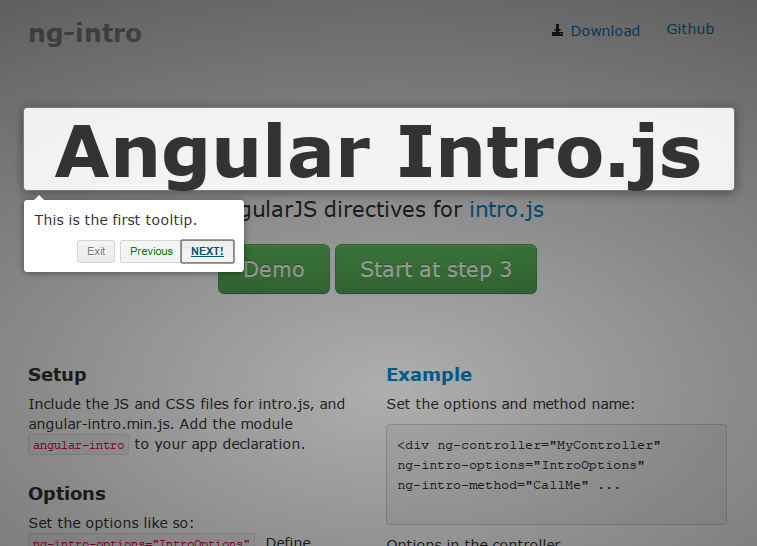An angularjs directive that wraps intro.js functionality.
See the project page for an overview.
You can install this package through NPM by using the following command :
npm install angular-intro.js --save
You can use this package in your webpack project, first by including intro.js and its css file. Next you need to require this package.
import ngIntro from 'angular-intro.js';
This project will return the whole angular module so if you want to use as a dependency in your own angular module you would need to reference the name ngIntro.name.
It's possible to include on your controller the service ngIntroService and customize as you need, or you may configure on your view the directives which are ng-intro-options, ng-intro-method and ng-intro-disable-button.
As a directive - ng-intro-options="IntroOptions"
As a service - ngIntroService.setOptions(IntroOptions)
You should create a $scope.IntroOptions in your controller which contains the intro.js options. The options are exactly the same as the original. This also allows you to modify the options as part of your controller behavior if necessary. You don't have to use IntroOptions, you can specify some other name.
As a directive - ng-intro-method="CallMe"
As a service - ngIntroService.start()
The directive will create a method on $scope.CallMe so that you can invoke it yourself later. Make sure the there isn't a method CallMe already in your controller. To use the method be sure to wrap it with $timeout. You don't have to use CallMe, you can specify some other name.
You can invoke it from an event such as click.
ng-click="CallMe();"
as long as you are still in the same controller scope. You can also specify a step number in the method call, CallMe(3);.
You can start the intro from code, either call $scope.CallMe();. If the $scope.CallMe(); doesn't work, it might be because your DOM isn't ready. Put it in a $timeout.
If you set ng-intro-autostart="true", the intro will start as soon as the directive is ready.
If an intro tour includes dynamic content, use ng-intro-autorefresh="true" to call Intro.js' refresh method.
Intro.js provides several callbacks. You can receive these callbacks in your controller. For example, for the onchange event, specify the function name in the directive.
ng-intro-onchange="ChangeEvent"
In your controller, create ChangeEvent
$scope.ChangeEvent = function (targetElement, scope) {
console.log("Change Event called");
console.log(targetElement); //The target element
console.log(this); //The IntroJS object
};The other intro.js callbacks you can specify are ng-intro-oncomplete, ng-intro-onexit, ng-intro-onchange, ng-intro-onbeforechange, ng-intro-onafterchange, ng-intro-onhintsadded, ng-intro-onhintclick and ng-intro-onhintclose.
In your controller:
ngIntroService.onComplete(function(){
console.log('on complete callback!')
});the list of current callbacks are:
onCompleteonExitonBeforeChangeonChangeonAfterChangeonHintClickonHintCloseonHintsAdded
The current short Interface is: p.s. it's avaiable on build folder the .d.ts file
intro: IntroJs;
addListener(name: string, callback: Function): void;
removeListener(name: string): void;
setOptions: IntroJs.Options;
start(stepId?: number): IntroJs;
exit(): IntroJs;
clear(callback: Function): IntroJs;
goToStepNumber(stepId: number): IntroJs;
addHints(): IntroJs;
showHint(hintIdx: number): IntroJs;
showHints(): IntroJs;
hideHint(hintIdx: number): IntroJs;
hideHints(): IntroJs;
removeHint(stepid: number): IntroJs;
removeHints(): IntroJs;
previous(): IntroJs;
next(): IntroJs;
refresh(): IntroJs;
onComplete(callback: Function): void;
onExit(callback: Function): void;
onBeforeChange(callback: Function): void;
onAfterChange(callback: Function): void;
onChange(callback: Function): void;
onHintClick(callback: Function): void;
onHintClose(callback: Function): void;
onHintsAdded(callback: Function): void; Directive - ng-intro-exit-method="ExitMe"
Callback - $scope.ExitMe(function() { //callback } );
You can also call $scope.ExitMe() from your controller.
Service - ngIntroService.exit()
Callback - ngIntroService.onExit(function(){ console.log('do something.'); });
You may use as Directive standalone without injecting ngIntroService as shown here
or
alternatively as Service, as shown here i've added the directive, but it's not required, it's there to show the compatibility between both
If you want to build or contribute, first, get the node modules needed (grunt, etc)
npm install
Then, get grunt to build the typescript into .js and the minified angular-intro.min.js
node_modules/.bin/grunt watch
p.s.: for faster build use `tsc --watch`, but you need run grunt after finish
Finally, view the demo page to make sure everything's working; start a web server:
./node_modules/.bin/grunt connect:server
And browse to http://localhost:8000/example/index.html
Same as intro.js, this is AGPL
